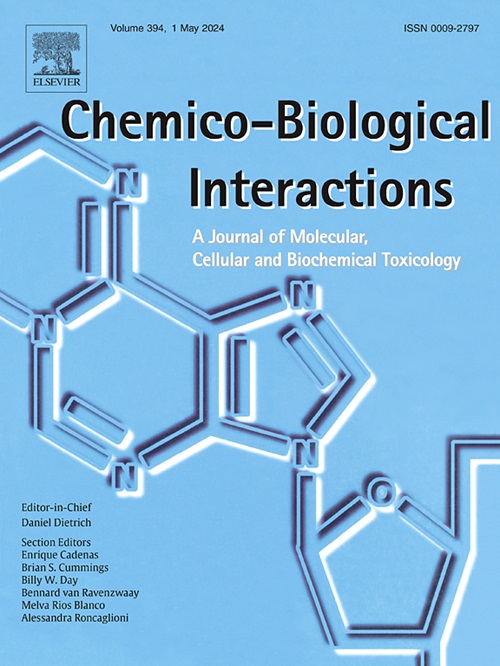利血平(生物碱)靶向Keap1/Nrf2的抗纤维化潜力氧化应激途径在ccl4诱导肝纤维化中的作用。
IF 4.7
2区 医学
Q1 BIOCHEMISTRY & MOLECULAR BIOLOGY
引用次数: 0
摘要
每年因肝癌死亡的人数接近 200 万,其中大部分是由于肝纤维化造成的。目前,还没有高效、安全、无毒的抗肝纤维化药物,这表明还有更好的药物研发空间。本研究旨在评估一种生物碱植物化合物--瑞香素对 CCl4 诱导的肝纤维化的抗纤维化作用。硅学对接分析表明,reserpine 与 keap1 蛋白相互作用,结合能为 -9.0 kcal/mol。在 HepG2 细胞中进行了体外生化分析、抗氧化指标和炎症细胞因子分析。该化合物无毒(4 次给药的 C57BL/6J 小鼠模型。对肝组织的形态变化进行了血色素和伊红以及马森染色。免疫组织化学(IHC)分析评估了利血平对肝纤维化标志物的影响。生化分析表明,小鼠模型经 6 周瑞舍平治疗后,ALT、AST 和 MDA 水平显著下降,过氧化氢酶水平升高。基因表达分析表明,利血平靶向氧化应激 Keap1/Nrf2 通路,下调 Keap1 表达 5 倍,上调 Nrf2 和 Nqo1 表达分别为 6 倍和 4.5 倍,显示了其抗氧化反应。它抑制了 Cyp2e1 的表达 2.2 倍,说明该化合物具有阻止脂质过氧化的能力。组织学和免疫染色显示,利舍平改善了肝细胞形态,减少了肝组织中胶原蛋白的沉积。与对照组相比,雷舍平治疗可使纤维化标志物α-SMA和Col-1分别降低1.3倍和1.5倍,并使miR-200a和miR-29b的表达分别增加15.5倍和8.2倍(p4通过靶向Keap1/Nrf2通路诱导C57BL/6J小鼠肝纤维化模型)。本文章由计算机程序翻译,如有差异,请以英文原文为准。

Antifibrotic potential of reserpine (alkaloid) targeting Keap1/Nrf2; oxidative stress pathway in CCl4-induced liver fibrosis
The death rate due to liver cancer approaches 2 million annually, the majority is attributed to fibrosis. Currently, there is no efficient, safe, non-toxic, and anti-fibrotic drug available, suggesting room for better drug discovery. The current study aims to evaluate the anti-fibrotic role of reserpine, an alkaloid plant compound against CCl4-induced liver fibrosis. In-silico docking analysis showed the interaction of reserpine with keap1 protein with the binding energy −9.0 kcal/mol. In-vitro, biochemical analysis, anti-oxidative indexes, and inflammatory cytokines analysis were performed in HepG2 cells. The non-toxic nature of the compound (<100 μg/ml) was evaluated through MTT assay in HepG2 and Vero cell lines. The antifibrotic potential of the reserpine compound (dose of 0.5 mg/kg) was assessed in CCl4-administered C57BL/6J mice models. Hematoxylin & Eosin and Masson staining were performed to study the morphological changes of liver tissues. Immune histochemistry (IHC) analysis was performed to evaluate the effect of reserpine on the liver fibrosis marker. The biochemical assay indicated a significant decrease in ALT, AST, and MDA levels and increased catalase enzyme post-6-week reserpine treatment in mice models. Gene expression analysis revealed that the reserpine targets oxidative stress Keap1/Nrf2 pathway and down-regulated Keap1 expression by 5-fold and up-regulated Nrf2 and Nqo1 expression by 6 and 4.5-fold respectively showing its antioxidant response. It suppressed the expression of Cyp2e1 by 2.2-fold, illustrating the compound's ability to block lipid peroxidation. Histological and immunostaining exhibited improved hepatocyte morphology and reduced collagen deposition in liver tissues due to reserpine. Reserpine treatment lowered the fibrotic markers α-SMA and Col-1 by 1.3 and 1.5 folds respectively as compared to the control group and increased the expression of miR-200a and miR-29b by 15.5 and 8.2 folds (p < 0.05) while decreased miR-128-1-5p expression by 5-fold. A comprehensive In-silico, In-vitro, and In-vivo analysis revealed that reserpine has a strong anti-fibrotic effect against the CCl4-induced liver fibrosis in C57BL/6J mice model by targeting the Keap1/Nrf2 pathway.
求助全文
通过发布文献求助,成功后即可免费获取论文全文。
去求助
来源期刊
CiteScore
7.70
自引率
3.90%
发文量
410
审稿时长
36 days
期刊介绍:
Chemico-Biological Interactions publishes research reports and review articles that examine the molecular, cellular, and/or biochemical basis of toxicologically relevant outcomes. Special emphasis is placed on toxicological mechanisms associated with interactions between chemicals and biological systems. Outcomes may include all traditional endpoints caused by synthetic or naturally occurring chemicals, both in vivo and in vitro. Endpoints of interest include, but are not limited to carcinogenesis, mutagenesis, respiratory toxicology, neurotoxicology, reproductive and developmental toxicology, and immunotoxicology.

 求助内容:
求助内容: 应助结果提醒方式:
应助结果提醒方式:


